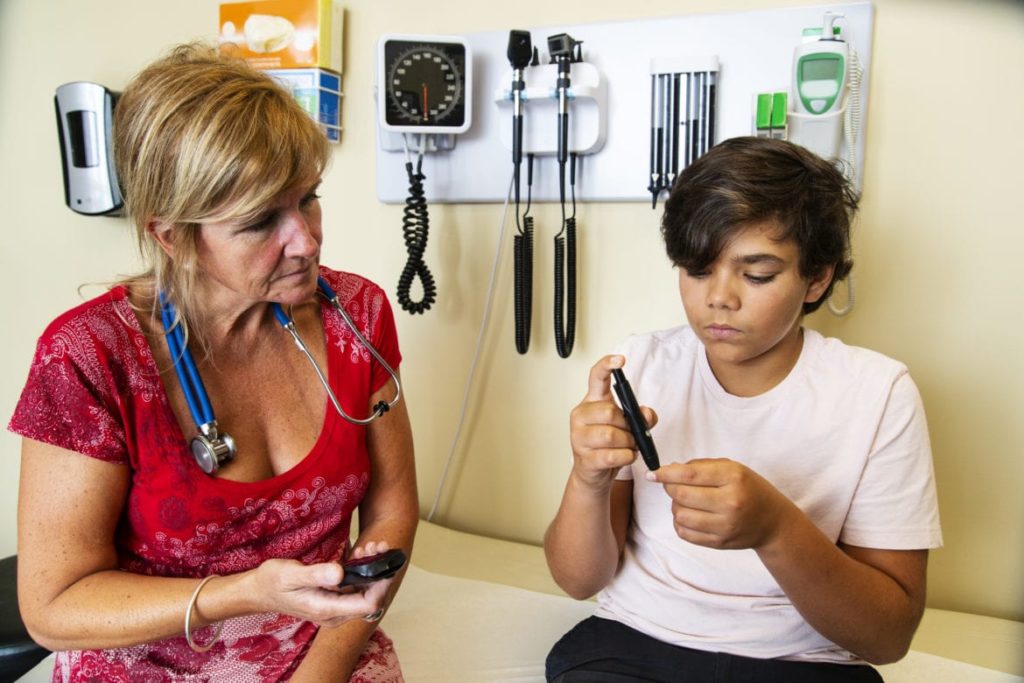Avoid Childhood Type 2 Diabetes With These Strategies
parentology

It’s becoming an epidemic. Per the Centers for Disease Control and Prevention (CDC), Childhood Type 2 Diabetes, 13.7 million US children (aged 2–19 years between 2015 and 2016) suffer from the condition.
The main culprit for this rise in Type 2 diabetes? Poor diet, which leads to obesity and ups the risk of developing the disease. According to Medical News Today, obesity increases the risk of type 2 diabetes by causing insulin resistance. This occurs when organs and tissues don’t respond appropriately to insulin or absorb enough sugar from the blood. Insulin resistance results in high blood sugar levels, a lower tolerance for glucose, added body-wide inflammation and a lifelong struggle with the disease.
The First Step in Avoiding Type 2 Diabetes
Nutritionist Robert Ferguson tells Parentology parents should look at family health history first. “If someone’s a type two diabetic, that lends itself to an increased likeliness a child could eventually find themselves being diabetic.”
Another trait, one that’s not always genetic, but usually lifestyle-related, is obesity. There are different ways to measure fat, but Ferguson recommends eschewing the Body Mass Index (BMI) for what he refers to as the Body Fact Index (BFI).
That means looking at your child’s actual body fat percentage, rather than the BMI, which is just a formula equating height and weight. Ferguson points out BMI, the basis of which are studies on cadavers in the 1880s, is outdated, whereas BFI is based on real numbers and algorithms. The site Stayhealthy.com offers tips for determining whether you or your child is at risk for Type 2 diabetes.
Educate Yourself About Food Choices
Ferguson says figuring out what makes a food “healthy” isn’t always an easy proposition. A common question, and ongoing issue, who determines what delineates a food as healthy?
“You may say free-range chicken is healthy, whereas a vegan friend will say no chicken is healthy,” Ferguson gives as an example.
For Ferguson, it’s more a mix and match food situation. “When it comes to diabetes with kids, same as with adults, the goal isn’t so much the specific food, but how much you consume at one time and what you eat with that food.”
One of the best strategies for addressing Type 2 diabetes is to avoid “sugar spikes,” sudden bursts of high sugar foods that cause a big release of insulin into the system. Slower, steadier metabolic burn is key to controlling blood sugar.

An example Ferguson gives of slowing sugar spikes –eating a yam, white potato or sweet potato, and adding butter. “The fat slows down how fast the carb becomes sugar in one’s blood, therefore, reducing the likelihood of experiencing a sugar spike,” he says. “And if you reduce the likelihood of a sugar spike, you also reduce the likelihood of insulin spike, which plays a huge role in the relationship between how we eat and whether or not we’re optimizing our blood sugar, which ties into type two diabetes for kids and adults.”
Adding fats or proteins to carbs is a good rule. Ferguson says, “Eating a slice of bread topped with peanut butter or almond butter will help slow down how fast the bread becomes sugar in the body.“
Cut Back On Empty Sugar
There is one big culprit, and it’s totally unnecessary: sugar. Not sugar like what’s in fruit, but the literal pounds of sugar Americans consume every year in processed foods, candy, and soft drinks.
However, even when it comes to eliminating sugar, Ferguson says it’s more complicated than just banning it. He points out that 40 years ago, kids also pounded sugar (Pixie Sticks, anyone?), but they exercised more.
Ferguson encourages looking at the big picture. “The biggest culprit can be over-consumption of candy, liquid sugary drinks and a lack of activity. The lack of education around nutrition, though, is the biggest culprit.”
Too often, Ferguson says, parents are left out of the equation. Kids get lectured at school, but no one reaches parents, who are ultimately making meal decisions.
“Statistically, we know if one parent is overweight or obese, the kid is 40% likely to become an overweight or obese adult. If both parents are overweight or obese, the kid is 80% likely to be overweight or obese as an adult. That says everything. You must go to the parents.”

Don’t Judge Food, Change Habits
One thing is certain: you don’t want your kids to see any food as forbidden fruit. Another thing to avoid is deception, like “sneaking” so-called healthy food into your kid’s diet.
“Habits are formed based on what kids grow up around — that’s where the power is,” Ferguson says.
These habits include, perhaps, letting your kid keep all their Halloween candy, but regulating how many pieces they get each day. Or, making sure they eat a balanced meal before going to that treat laden holiday party. It also means letting your child have so-called “junk” food on occasion, but also presenting fresh fruit as dessert on the regular.
He warns about bringing judgment into the mix. If they do, “That kid is going to start hiding food under the bed or visiting friend’s house where they can drink regular soda.”
As with most things, avoiding the pitfalls of Type 2 diabetes is mostly about balance.
If you suspect your child might be suffering from Type 2 diabetes, book an appointment with a pediatrician. Early intervention can garner good results.